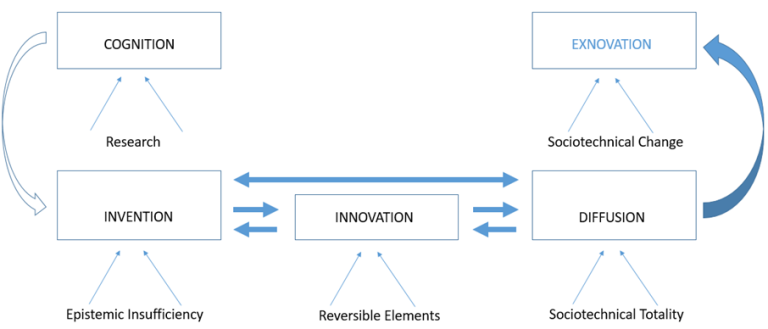A way out of the Collingridge dilemma
Pandemic, climate crisis, food shortages. This is, unfortunately, just a short list of the serious issues of our current time. We are facing several problems, which are part of a complex structure. We find ourselves in a world with intertwined, multiple crises and wicked problems, which are hardly possible to understand or easy to solve.
As it seems, this kind of problem structure and dynamics are quite new and characteristic for the current state of our reflexive (Beck 1993) and regressive modernity (Nachtwey 2016). Although some mechanisms have roots in decades old, ongoing transformations as described by Karl Polanyi in his book The Great Transformation (1944). Surprisingly, however, there are several continuities in trying to handle them. I want to stress on two – the idea of technological fix and the model of linear innovation – and make some remarks on a promising notion for a way out of the Collingridge dilemma (1981), the exnovation approach.
Still Relevant: Technology as a Solution for Everything
It is somehow normal for us to refer to technological and pro-innovation based solutions for wicked problems. Just to give examples in short for the ones stated above: During the pandemic the main solution to break infection chains was seen in innovations like downloadable apps for contact tracing and vaccinations. To counter the climate crisis and energy shortages it is regularly pointed to pinwheels and solar energy, or even to auspicious, extraordinary geo-engineering technologies. And food shortages or diseases caused by food could be restrained at least with in-vitro produced or mechanically altered food as it is practiced already.
The idea of a technological fix is over-present for solutional approaches to problems, which are partly caused by other technologies introduced before
This example listing is not about evaluating those attempts in general. But it is surprising, that the idea of a technological fix is at the forefront to resolve such problems, which are partly caused by other technologies introduced before, so to say by their ‘technological relatives’.

Image by Gerd Altmann on Pixabay
As we know, for instance from investigations of Science and Technology Studies (STS), technologies do not just emerge somehow in isolation in laboratories, start-up’s and engineering offices and then get applied in clearly limited societal fields. Quite more happens, when developed technologies are introduced and a diffusion takes place in society: An updated, new sociotechnical totality (Ropohl 2009) arises. This is far more than technology is perceived and discussed as an add-on in the sense of a tool, which just gets added to an existing societal body and is then fully under control by its human users without any changes for them.
This is clearly not the case, when technologies are introduced to society, as a brief look to past technology diffusions does show. The internet and the smartphone, for example, totally changed their users, sociotechnical circumstances, socioeconomics, technopolitics and, not to forget, technomoralities (Swierstra 2013), which in no way were even roughly expected. One might argue, that although we didn’t managed to anticipate such shifts ex ante, we are not negatively affected by those or, at least, that the positive aspects prevailed the negative ones. This ex post evaluation might be right, but even so, it is hardly ignorable that this is just the case mainly because of luck, not because of far-sighted wisdom of politicians, researchers, tech developers or other members of society.
To put this in perspective with an example: What would we have done, if the conspiracy theorists were in the right saying the cellphone masts do cause serious diseases? It is hardly imaginable, how we would or even could have taken the whole internet infrastructure ‘back’ in such a case.
This might sound too speculative for some of us, but given a more realistic and tangible example should make the problem and solution horizon clearer. The climate crisis is luckily accepted and recognized by most people as a huge problem. And we know at least, that nuclear power plants and coal-fired power stations are less part of the solution, than of the problem¹.
So, how great would it be, if we easily could remove those crisis accelerators, and reorganize our energy source and flow infrastructures? Sure, this is a political and economic question on one side, but also – and this is not to underestimate – a real technical challenge on the other side, since the electricity infrastructure, for example, has further developed in regard to the energy plants and vice versa. These energy plants and coal-powered stations are at the core for our current sociotechnical infrastructure, which makes removing not impossible, but really difficult.
Modification in Need: Reversible Instead of Irreversible Technology
But is there a different way for these infrastructures to be built instead? The claim is: If there had been installed reversible elements instead of mainly focusing on innovative elements in the designing process of infrastructural technologies, the situation today would look different with far more options. Here, exnovation comes into play. Exnovation is a term, which was introduced in the 1980es (Kimberley 1981) and can be understood as a process to remove or rather make technologies removable by designing them to be reversible from the very beginning. By such a design, they still can get removed and recycled after their diffusion to society, if they turn out as useless or harmful.
If there had been installed reversible elements instead of mainly focusing on innovative elements in the designing process of infrastructural technologies, the situation today would look different with far more options.
Inscribed reversible elements in innovations keep options open for unpredictable futures, instead of closing them down artificially and with high uncertainties. Because of our epistemic insufficiency (Blok et al. 2015) we will not be able to predict or govern the future, and just innovating is not sufficient enough to help us out – it could even get worse. But luckily there is exnovation, which helps us to find a way out of this well-known Collingridge dilemma (Collingridge 1981): With an exnovation approach it is acceptable to not know about all potential future side effects of an emerging innovation on society. Given this uncertainty, reversible elements are inscribed in the very beginning, which will help to take the innovation back, if it turns out as useless or harmful.
Exnovation is not a fully new thing, but the appropriate innovation for the 21st century, which has to be taken seriously to approach to our serious problems. The common linear model of innovation (Ropohl 2009) with its main phases 1. Invention, 2. Innovation and 3. Diffusion can at least be developed to a model of exnovation with 4. Exnovation (see graphic).

Model of Exnovation (own illustration based on Ropohl 2009)
I don’t argue for an innovation stop; it is quite the opposite. I argue for figuring out, what necessities and possibilities we have to consider to make innovations flourish and not harming in the long run, without naively trying to predict an unpredictable future and without following an irresponsible trial and error innovation logic. The most convincing way to do so is by further investigations in exnovation studies including exnovation theory and practice (Holbek et al. 2020), by bringing together existing conceptual frameworks (i.e. abandonment, disarticulation, disinvestment, dismantlement, elimination, termination, unlearning, unmaking of technology, s. recently Velkova et al. 2023), evolving a shared perspective and finding best-practices to encourage stakeholders and promote appropriate incentives for exnovations.
Footnotes
- On the other hand, they do cushion the energy shortage in Europe since the Russian invasion. This shows how intertwined the multiple crises mentioned before are.
- Of course, the notion of linearity does already imply some presuppositions, which ignore the practical evolving of technologies with far more fluidity and bidirectionality. Therefore, some arrows were added to the linear model, marking the fact of unclear causalities within the innovation process.
References
Beck, Ulrich (1993): Die Erfindung des Politischen. Zu einer Theorie reflexiver Modernisierung. Frankfurt a.M.: Suhrkamp.
Blok, Vincent/ Lemmens, Pieter (2015): The Emerging Concept of Responsible Innovation. Three Reasons Why It Is Questionable and Calls for a Radical Transformation of the Concept of Innovation. In: Koops, Bert-Jaap/ Oosterlaken, Ilse/ Romijn, Henny/ Swierstra, Tsjalling/ van den Hoven, Jeroen: Responsible Innovation 2. Concepts, Approaches, and Applications. New York: Springer International.
Collingridge, David (1981): The social control of technology. London: Palgrave.
Holbek, Jonny/ Knudsen, Harald (2020): On the Concept of Exnovation – A Call for a Rebirth of the Concept, and for Exnovation Theory and Practice. Kristiansand: University of Agder. Online: https://uia.brage.unit.no/uia-xmlui/bitstream/handle/11250/2655865/Knudsen.pdf?sequence=2 (last access 20/01/2023).
Kimberly, John (1981): Managerial innovation. In: Nystrom, Paul/ Starbuch, William: Handbook of Organisational Design. Oxford: Oxford University Press.
Nachtwey, Oliver (2016): Die Abstiegsgesellschaft. Über das Aubegehren in der regressiven Moderne. Berlin: Suhrkamp.
Polanyi, Karl (1944): The great transformation. New York: Farrar & Rinehart.
Ropohl, Günter (2009): Allgemeine Technologie. 3rd edition. Karlsruhe: Universitätsverlag.
Swierstra, Tsjalling (2013): Nanotechnology and Technomoral Change. In: Etica & Politica: XV. 1.
Velkova, Julia/ Cohn, Marisa (2023): (Un)timely Endings. Negotiating Sociotechnical relations in their unmaking. Call for Papers. In: Nordic STS Conference: Accepted panels. Online: https://www.sv.uio.no/tik/english/research/news-and-events/events/conferences/2023/nordic-sts/accepted-panels.html (last access 22/01/2023).



